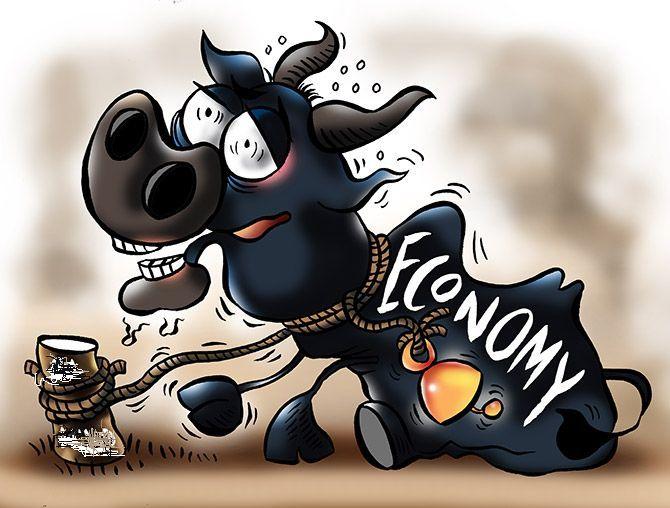The trio, 'twin shocks' of demonetisation and GST, 'twin balance sheet' problem that has been weakening India’s banking system and the 'twin deficit' problem will continue to challenge economic management and performance in the year ahead, says Shankar Acharya.
Illustration: Uttam Ghosh/Rediff.com

Over the past year, two pairs of twins have dominated economic developments in India.
The first refers to the “twin shocks” of demonetisation (Demon for short) of November 2016 and the implementation challenges of the new Goods and Services Tax (GST) from July 2017.
The second refers to the legacy problems of the long-festering “twin balance sheet” burden of massive non-performing assets (NPAs) of banks, especially public sector banks (PSBs), and the corresponding overhang of unserviced debt of the Indian corporate sector, both of which have been throttling investment and production in the Indian economy.
As the calendar year comes to a close, a third pair of twins may be emerging, that is, the familiar problem of “twin deficits”: In the fiscal accounts and the balance of payments.
A huge amount has been written about DeMon, some of it on partisan lines.
By now, 13 months after the initial shock, most mainstream analysts broadly agree that the visible, short-run, disruption costs on output, earnings, and employment outweighed the uncertain long-term gains of higher tax compliance, reduced corruption, and faster digitisation of transactions.
Gross domestic product (GDP) growth in the three quarters between October 2016 and June 2017 probably suffered by 1-2 per cent (annualised), although not yet fully reflected in the official data, since the non-agricultural informal/unorganised sector (accounting for about a quarter of GDP) is not adequately measured in contemporary estimates.
Yet, being very cash-intensive, this sector suffered disproportionately from Demon. Official data on the damage to employment is non-existent.
Recent surveys by the Centre for Monitoring the Indian Economy indicate significant job losses, but the estimates may not account adequately for seasonal factors.
Many journalist accounts of DeMon’s impact on unorganised sector production clusters in places such as Kanpur (leather, garments), Tirupur (knitwear), Ludhiana (textiles, garments, hosiery), and Bhiwandi (textiles) suggests that the negative impact on output, earnings, and employment might be in the order of 20-30 per cent and quite persistent.
With remonetisation nearly complete by spring 2017, some recovery was underway, when it was hit by the new GST, with its multiple rates, complex registration and compliance procedures, weak technology network and software and divided jurisdictions.
These were particularly burdensome and disruptive for the unorganised/informal sector units, for whom this was the second shock in eight months.
While the government and the GST Council have been responsive to myriad complaints, major problems still persist, especially for exporters and small-scale providers of goods and services.
Long delays in providing refunds to exporters (exports are zero-rated in the GST) have damped India’s export performance just when world trade and output are growing at their fastest rate since 2008.
Markets now lost may not be easily regained, especially with our over-valued exchange rate for the rupee.
Both DeMon and the GST encourage formalisation of economic activity and transactions.
This would be fine if our labour market was flexible and encouraged transition of employment from the unorganised to the organised sector.
The opposite is true. Our labour laws and rules are some of the most complex and cumbersome in the world.
They greatly discourage organised sector employers from fresh hiring.
Unsurprisingly, organised sector employment accounts for less than a fifth of the labour force.
So, a lasting effect of DeMon and the GST could be to trap even higher proportions of our low-skilled labour force in low-paid jobs and under-employment, with massively disruptive social and political consequences.
The urgency of labour law reform is now greater than ever.
The twin balance sheet problem has been weakening India’s banking system, corporate investment, and overall economic performance for over five years.
Its awesome scale became increasingly apparent after the Reserve Bank of India (RBI) launched its Asset Quality Review system in early 2015.
By March 2017, stressed assets accounted for over 12 per cent of total bank advances, with the proportion being greater than 15 per cent for PSBs.
Over the past 18 months, the government and RBI have unfolded a multi-pronged strategy to deal with this enormous challenge. It includes:
The legislation of the Insolvency and Bankruptcy Code (IBC), including its recent tightening by Ordinance; the RBI-led referrals of large defaulters (beginning with the big “dirty dozen”) to the National Company Law Tribunal for bankruptcy proceedings; and the dramatic announcement, seven weeks ago, of a massive, Rs 2.11 lakh crore (1.3 per cent of GDP) recapitalisation package for PSBs, the full details of which remain to be spelt out.
Subject to the fine print and the quality and strength of the conditionalities for PSB reform, this strategy constitutes a bold and promising approach to a long-festering problem.
If done well, it could resurrect bank credit growth, increase corporate investment, speed transfer of productive assets to more efficient owners and managers, enhance the quality and efficiency of PSBs and revive overall economic growth over the next two years.
There will be sizable fiscal costs and major implementation challenges. But something of this scale and nature needed to be done.
As the calendar year draws to a close, a familiar “twin deficit” problem is gaining strength.
With revenues from the GST showing a 9.5 per cent drop in October over September and further declines likely because of recently announced rate reductions, the RBI transferring less than half the amount transferred to the government in FY17, and with expenditures buoyant, the Centre’s fiscal deficit target of 3.2 per cent of GDP is under severe pressure.
By October, it had already crossed 96 per cent of the full financial year Budget target and interest rates have hardened.
An over-shooting by around half a per cent of GDP looks quite likely, even without taking account of any fiscal jugglery associated with the bank recapitalisation bonds.
Together with continued pressure on weak state finances, a combined deficit of about 7 per cent of GDP is very possible.
On the external front, the current account deficit jumped to 2.4 per cent of GDP in 2017-18 Q1 from 0.7 per cent in 2016-17, thanks to sluggish goods exports (running over 10 per cent below the peak level of 2013-14), surging imports (boosted by higher oil prices), and slowing software exports.
This trio of troublesome twins will continue to challenge economic management and performance in the year ahead.
Shankar Acharya is honorary professor at ICRIER and former chief economic advisor to the Government of India. Views are personal.











